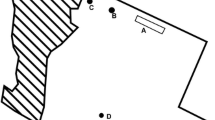Summary
The seventh case of cryptococcosis in a cat is described. The animal involved was a five-year-old Maltese short hair that had lived in Connecticut all of its life. An investigation was carried out to discover the point source of this feline infection. This search was unsuccessful but it did result in the isolation ofH. capsulatum for the first time from Connecticut soil.
In addition, the preliminary findings of a study to evaluate the use of the fluorescent antibody technique for the rapid detection ofH. capsulatum in soil are reported. Round to oval forms measuring 1.5 to 3.5 microns in diameter were demonstrated in smears of the positive Connecticut soil that had been stained with fluorescein labeled anti-H. capsulatum globulins. The morphology of these elements was similar to that of the microconidia ofH. capsulatum. Through the use of this immune conjugate five additional positive soil samples from other areas were also shown to contain these forms. None of these six soils showed stained elements when treated with normal conjugates. The implications of these findings are discussed.
Similar content being viewed by others
References
Ajello, L. &Runyon, L. C. (1953). Infection of mice with single spores ofHistoplasma capsulatum. J. Bact.66 34–40.
Ajello, L. (1958). Occurrence ofCryptococcus neoformans in soils. Amer. J. Hyg.67 72–77.
Brown, J. H., Cook, K. M., Ney, F. G. &Hatch, T. (1950). Influence of particle size upon retention of particulate matter in the human lung. Amer. J. Pub. Health40 451–459.
Cozad, G. C. &Furculow, M. L. (1953). Laboratory studies ofHistoplasma capsulatum. II. Size of spores, J. Infect. Dis.92 77–84.
Emmons, C. W. (1951). Isolation ofCryptococcus neoformans from soil. J. Bact.62 685–690.
Emmons C. W. (1955). Saprophytic sources ofCryptococcus neoformans associated with the pigeon (Columba livia). Amer. J. Hyg.62, 227–232.
Emmons, C. W. (1960). Prevalence ofCryptococcus neoformans in pigeon habitats. Pub. Health Rep.75 362–364.
Goldwasser, R. A. &Kissling, R. E. (1958). Fluorescent antibody staining of street and fixed rabies virus antigens. Proc. Soc. exp. Biol. Med.98 219–223.
Holzworth, J. (1952). Cryptococcosis in a cat. Cornell Vet.42 12–15.
Holzworth, J. &Coffin, D. L. (1953). Cryptococcosis in the cat: A second case. Cornell Vet.42 546–550.
Kao, C. J. &Schwarz, J. (1957). The isolation ofCryptococcus neoformans from pigeon nests. Amer. J. clin. Path.27 652–663.
Kaplan, W. &Ivens, M. S. (1960). Fluorescent antibody staining ofSporotrichum schenckii in cultures and clinical materials. J. Invest. Derm. In press.
Littman, M. L. &Zimmerman, L. E. (1956). Cryptococcosis. New York. Grune and Stratton, p. 205.
Littman, M. L. &Schneierson, S. S. (1959).Cryptococcus neoformans in pigeon excreta in New York City. Amer. J. Hyg.69 49–59.
Lodder, J. &Kreger-Van Rij, N. J. W. (1952). The yeasts: A taxonomic study. Amsterdam. North Holland Publishing Co. (See p. 380 and footnote, p. 375.)
Loosli, C. G., Beadenkopf, W. G., Rice, F. A. &Savage, L. J. (1951). Epidemiological aspects of histoplasmin, tuberculin, and coccidioidin sensitivity. Amer. J. Hyg.53 33–57.
McGrath, J. T. (1954). Cryptococcosis of the central nervous system in domestic animals. Amer. J. Path.30 651.
Manos, N. E., Ferebee, S. H. &Kerschbaum, W. F. (1956). Geographic variation in the prevalence of histoplasmin sensitivity. Dis. Chest29 649–668.
Moody, M. D., Ellis, E. C. &Updyke, E. L. (1958). Staining bacterial smears with fluorescent antibody. IV. Grouping streptococci with fluorescent antibody. J. Bact.75 553–560.
Thomason, B. M., Moody, M. D. &Goldman, M. (1956). Staining bacterial smears with fluorescent antibody. II. Rapid detection of varying numbers ofMalleomyces pseudomallei in contaminated materials and infected animals. J. Bact.72 362–367.
White, F. H. &Ristic, M. (1959). Detection ofLeptospira pomona in guinea pig and bovine urine with fluorescein labeled antibody. J. Infect. Dis.105 118–123.
Yamamoto, S., Ishida, K. &Sato, A. (1957). Isolation ofCryptococcus neoformans from pulmonary granuloma of a cat and from pigeon droppings. Jap. J. vet. Sci.19 179–194.
Author information
Authors and Affiliations
Rights and permissions
About this article
Cite this article
Kaplan, W., Ajello, L., Di Bitetto, D.B. et al. The discovery ofHistoplasma capsulatum in Connecticut soil incidental to the investigation of a case of feline cryptococcosis. Mycopathologia et Mycologia Applicata 14, 1–8 (1961). https://doi.org/10.1007/BF02051431
Issue Date:
DOI: https://doi.org/10.1007/BF02051431




